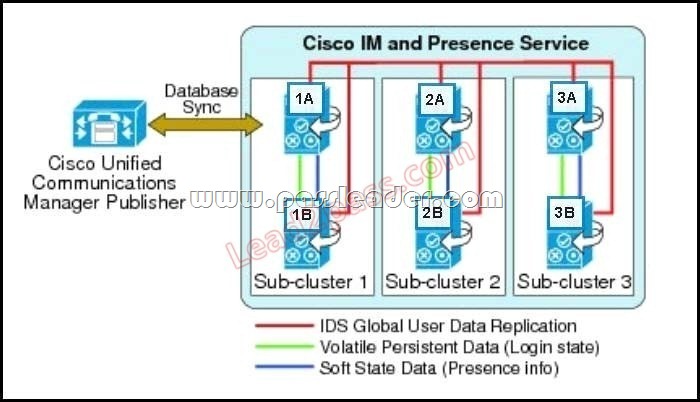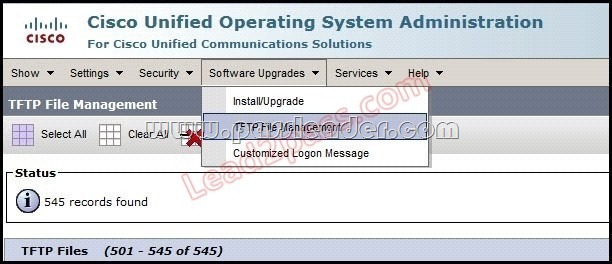New 400-051 exam questions from PassLeader 400-051 dumps! Welcome to download the newest PassLeader 400-051 VCE and PDF dumps: http://www.passleader.com/400-051.html (661 Q&As~~~2019 NEW VERSION!!!)
P.S. Free 400-051 dumps are available on Google Drive shared by PassLeader: https://drive.google.com/open?id=0B-ob6L_QjGLpNnliRG04bG9GbEk
QUESTION 71
Which statement describes the call recording operation on Cisco Unified Contact Center Express call agents that use Cisco IPPA?
A. Recording is facilitated via desktop monitoring on supported IP phones.
B. Automatic recording is supported.
C. Only G.711 codec is supported.
D. Only SPAN port monitoring is supported.
E. Call recording is not supported on Cisco Unified CCX call agents that use Cisco IPPA.
Answer: D
Explanation:
There is no mechanism created as of now to record the call so we first span and record it from packet capture or from third party software.
QUESTION 72
Which protocol that is used between Cisco IM and Presence and Cisco Unified Communications Manager is responsible for the exchange of phone state presence information?
A. AXL/SOAP
B. CTI/QBE
C. SIP/SIMPLE
D. LDAP
E. XMPP
Answer: C
Answer: C
Explanation:
To provide interoperability between communications systems, SIP is the protocol leveraged. Enterprise Presence solutions need to provide for a uniform definition of the main communication services such as IM, voice, video, e-mail, web calendaring, and so on, while SIP delivers the necessary features.
QUESTION 73
Refer to the exhibit. In this high-availability Cisco IM and Presence deployment with three subclusters, the first user is assigned to server 1A; the second user is assigned to server 2A; and the third user is assigned to server 3A. Assume that the Cisco IM and Presence is set to Active/Standby mode, to which server should the fourth user be assigned?

A. 1A
B. 3B
C. 1B
D. 2A
E. 3A
Answer: A
Explanation:
This deployment model provides the same level of redundancy and high availability as outlined in the “Balanced Redundant High-Availability Deployment” section in this chapter. The only difference is that users are not deployed in a balanced fashion, but rather all reside on the primary server in the subcluster, and the backup server is there as a standby option if a node failure occurs.
QUESTION 74
Which two enterprise presence domains can federate with Cisco IM and Presence by using SIP? (Choose two.)
A. AOL
B. Microsoft OCS
C. IBM Sametime
D. Cisco WebEx Connect
E. Google Talk
F. Cisco Unified Presence 8.X Releases
Answer: AB
Explanation:
Microsoft Lync and OCS support presence services with sip as well as AOL so to sip is easy to troubleshoot and feasible for signaling that’s why cisco federate these with sip.
QUESTION 75
Which statement describes the external database requirement for the Cisco IM and Presence permanent group chat feature?
A. All nodes in a Cisco IM and Presence cluster can share a physical external database.
B. All nodes in a Cisco IM and Presence cluster can share a logical external database.
C. Each node in a Cisco IM and Presence cluster must have its own physical external database.
D. Each node in a Cisco IM and Presence cluster must have its own logical external database.
E. An external database is not mandatory.
Answer: D
Explanation:
When you configure an external database entry on IM and Presence, you assign the external database to a node, or nodes, in your cluster as follows:
For the Compliance feature, you require at least one external database per cluster. Depending on your deployment requirements, you can also configure a separate external database per node.
For the Permanent Group Chat feature, you require a unique external database per node. Configure and assign a unique external database for each node in your cluster.
If you deploy both the Permanent Group Chat and Compliance features on an IM and Presence node, you can assign the same external database to both features.
QUESTION 76
Which external database software is required for the Cisco IM and Presence compliance feature?
A. MySQL
B. EnterpriseDB
C. MSSQL
D. SQLite
E. PostgreSQL
Answer: E
Explanation:
http://www.cisco.com/en/US/docs/voice_ip_comm/cups/8_0/english/install_upgrade/database/guide/Preparing_database_setup.html#wp1053954
QUESTION 77
Which Cisco IM and Presence service is responsible for logging all IM traffic that passes through the IM and Presence server to an external database for IM compliance?
A. Cisco Presence Engine
B. Cisco Serviceability Reporter
C. Cisco Sync Agent
D. Cisco XCP Connection Manager
E. Cisco XCP Message Archiver
Answer: E
Explanation:
The Cisco Unified Presence XCP Message Archiver service supports the IM Compliance feature. The IM Compliance feature logs all messages sent to and from the Cisco Unified Presence server, including point-to-point messages, and messages from adhoc (temporary) and permanent chat rooms for the Chat feature. Messages are logged to an external Cisco-supported database.
QUESTION 78
Which two statements about the Cisco UC on UCS specs-based virtualization support model are true? (Choose two.)
A. It has a configuration-based approach.
B. It has a rule-based approach.
C. It has less hardware flexibility compared to the third-party server specs-based support model.
D. It has less hardware flexibility compared to the UC on UCS TRC support model.
E. VMware vCenter is optional with this support model.
Answer: BC
Explanation:
http://docwiki.cisco.com/wiki/UC_Virtualization_Supported_Hardware#UC_on_UCS_Tested_Reference_Configurations
QUESTION 79
Which definition is included in a Cisco UC on UCS TRC?
A. required RAID configuration, when the TRC uses direct-attached storage
B. configuration of virtual-to-physical network interface mapping
C. step-by-step procedures for hardware BIOS, firmware, drivers, and RAID setup
D. configuration settings and patch recommendations for VMware software
E. server model and local components (CPU, RAM, adapters, local storage) by name only; part numbers are not included because they change over time
Answer: A
Explanation:
Definition of server model and local components (CPU, RAM, adapters, local storage) at the orderable part number level. Required RAID configuration (e.g. RAID5, RAID10, etc.) – including battery backup cache or SuperCap – when the TRC uses DAS storage Guidance on hardware installation and basic setup. Design, installation and configuration of external hardware is not included in TRC definition, such as:
Configuration settings, patch recommendations or step by step procedures for VMware software are not included in TRC definition.
Infrastructure solutions such as Vblock from Virtual Computing Environment may also be leveraged for configuration details not included in the TRC definition.
QUESTION 80
Which capability is support by LLDP-MED but not by Cisco Discovery Protocol?
A. LAN speed discovery
B. network policy discovery
C. location identification discovery
D. power discovery
E. trust extension
Answer: A
Explanation:
LLDP-MED supports both LAN speed and duplex discovery. Cisco Discovery Protocol supports duplex discovery only, but this limited support is not seen as a problem because if there is a speed mismatch, LLDP-MED and Cisco Discovery Protocol cannot be exchanged and thus cannot be used to detect the mismatch.
QUESTION 81
In a Cisco EnergyWise domain, which two terms describe a Cisco IP phone? (Choose two.)
A. endpoint
B. domain member
C. child domain member
D. EnergyWise agent
E. Cisco power distribution unit
Answer: AC
Explanation:
http://www.cisco.com/en/US/docs/switches/lan/energywise/phase2_5/ios/configuration/guide/one_ent.html
QUESTION 82
Which statement about Cisco EnergyWise domain member neighbor formation is true?
A. Cisco EnergyWise supports static neighbors, but the neighbor relationship is only possible if a noncontiguous domain member and a contiguous domain member have a static neighbor entry pointing to each other.
B. Cisco EnergyWise static neighbors can be formed even if domain members are not physically contiguous.
C. Static neighbors can be manually defined on Cisco EnergyWise domain members, but TCP protocols must be used.
D. Static neighbors can be manually defined on Cisco EnergyWise domain members, but they have a lower priority compared to the autodiscovered members.
E. Static neighbors can be manually defined on Cisco EnergyWise domain members and the TCP or UDP protocol can be used.
Answer: B
Explanation:
http://www.cisco.com/en/US/docs/solutions/Enterprise/Borderless_Networks/Energy_Management/energywisedg.html?referring_site=smartnavRD#wp554384
QUESTION 83
Refer to the exhibit. Assuming that the administrator has never performed any manual custom uploads, which two file types can be found when you choose Software Upgrades, followed by TFTP File Management on the Cisco Unified Operating System Administration web page for Cisco Unified Communications Manager? (Choose two.)

A. IP phone configuration files
B. announcement audio files
C. ringer files
D. IP phone license files
E. sample music-on-hold audio files
F. softkey template files
Answer: BC
Explanation:
The two file types that we get are Announcement Audio Files and Ringer Files.
QUESTION 84
Which four attributes are needed to determine the time to complete a TFTP file transfer process? (Choose four.)
A. file size
B. file type
C. network interface type
D. round-trip time
E. packet loss percentage
F. response timeout
G. network throughput
Answer: ADEF
Explanation:
Four attributes that are needed to determine the time to complete TFTP file transfer process is:
File Size
Round-trip time
Packet loss percentage
Response timeout
http://www.cisco.com/en/US/prod/collateral/voicesw/ps6882/ps6884/white_paper_c11-583891_ps10451_Products_White_Paper.html
QUESTION 85
Which device is the initiator of a StationD message in a Cisco Unified Communications Manager SDI trace?
A. SCCP IP phone
B. SIP IP phone
C. Cisco Unified Communications Manager
D. MGCP analog gateway
E. digital voice gateway
Answer: C
Explanation:
All messages to and from a skinny device are preceded by either the words Stationd or StationInit. StationD messages are sent from call manager to IP phone.Skinny message transmission such as this between the IP phone and CallManger occurs for every action undertaken by the IP phone,including initialization,registration,on-hook,off- hook,dialing of the digits,key press on the phone,and so much more.
New 400-051 exam questions from PassLeader 400-051 dumps! Welcome to download the newest PassLeader 400-051 VCE and PDF dumps: http://www.passleader.com/400-051.html (661 Q&As~~~2019 NEW VERSION!!!)
P.S. Free 400-051 dumps are available on Google Drive shared by PassLeader: https://drive.google.com/open?id=0B-ob6L_QjGLpNnliRG04bG9GbEk





